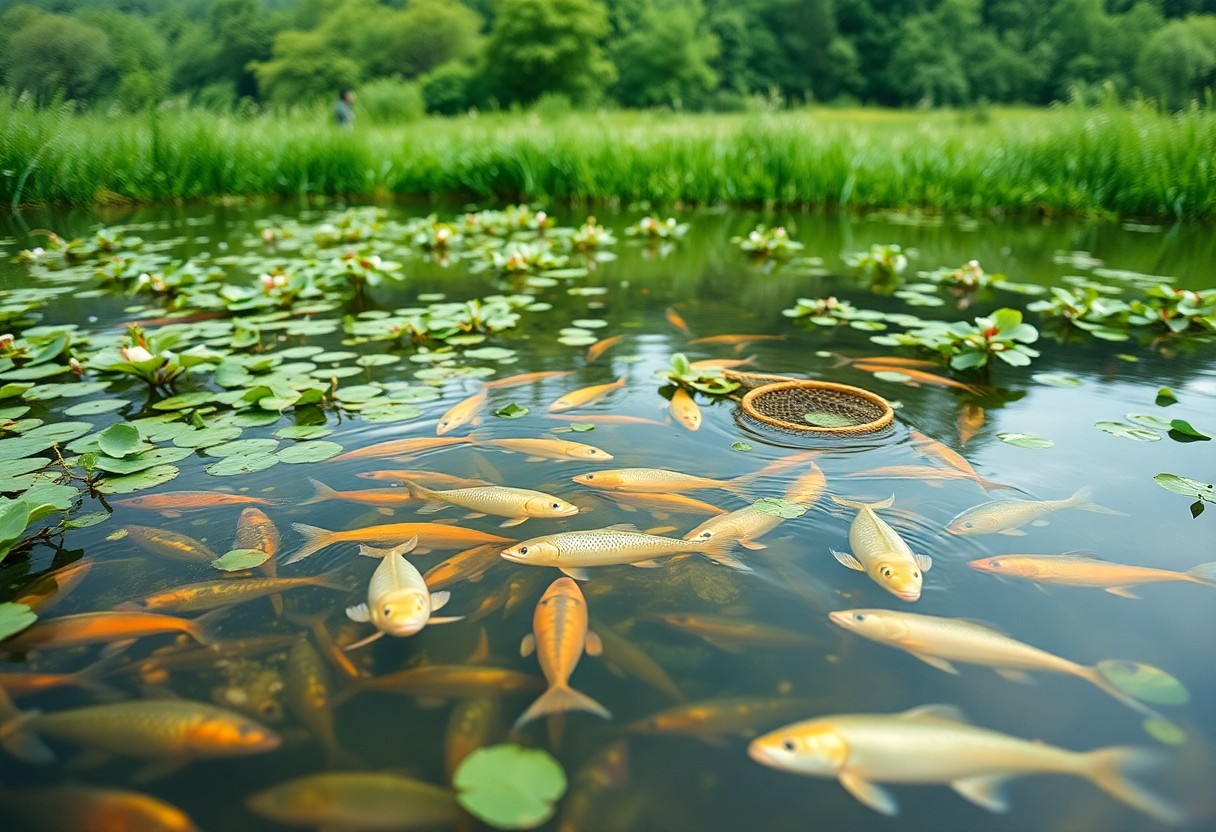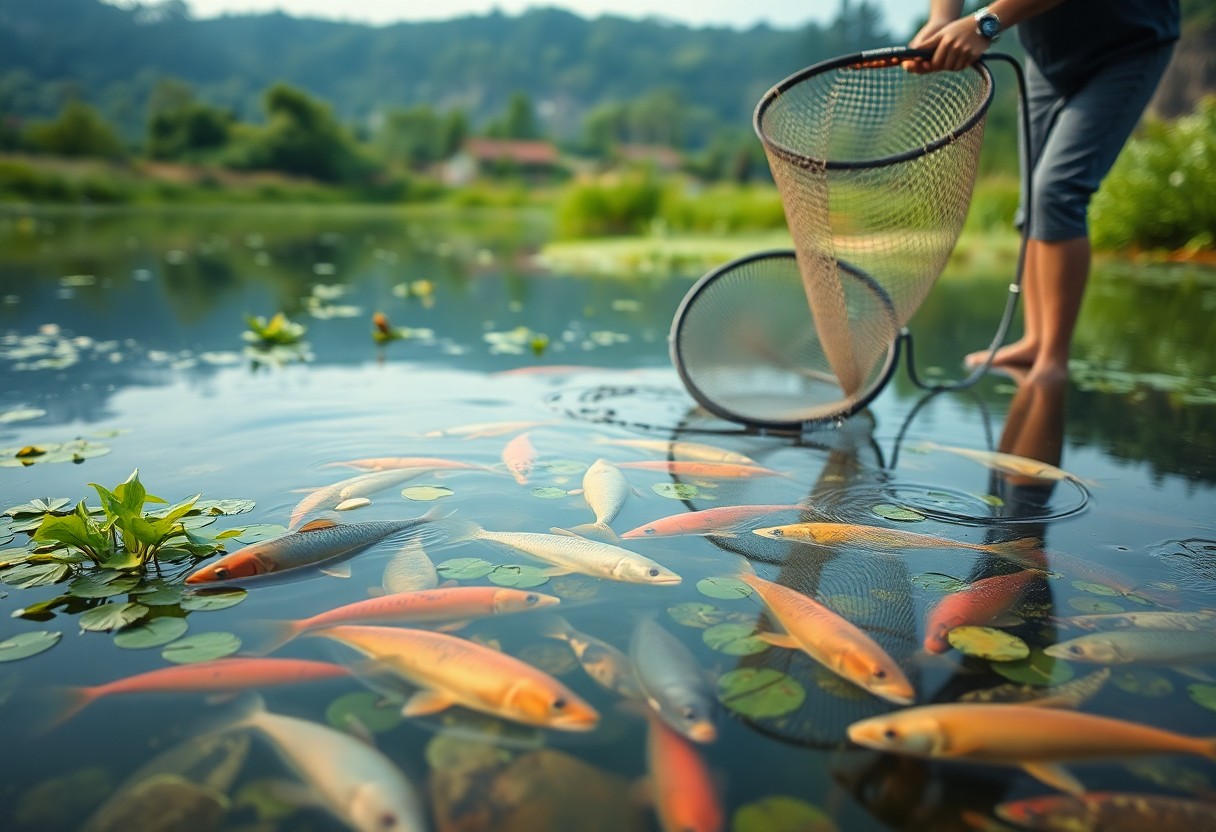Most pond owners overlook the importance of managing their fish population, which can lead to overcrowding. This not only harms your fish but can also disrupt the ecosystem of your pond, leading to poor water quality and stunted fish growth. In this post, you will learn effective strategies to maintain a healthy balance in your pond, ensuring that your aquatic friends thrive while preventing issues related to overpopulation. With the right techniques, you can enhance the health of your pond and create a harmonious environment for all its inhabitants.
Table of Contents
Key Takeaways:
- Monitor fish food supply and consumption to prevent overpopulation and malnutrition.
- Introduce natural predators, like certain bird species or larger fish, to help regulate smaller fish populations.
- Implement seasonal harvesting to maintain balance and promote healthier fish growth.
- Maintain water quality through regular testing and natural filtration methods to support a stable ecosystem.
- Consider creating different zones within the pond to provide varying habitats for fish and other aquatic life.

Understanding Pond Ecosystem Basics
A healthy pond ecosystem relies on a delicate balance of various components, including plants, fish, microorganisms, and water quality. As a pond owner, it’s crucial to understand how these elements interact and influence one another. By maintaining this balance, you can ensure a thriving habitat for your pond fish and other wildlife, ultimately leading to a sustainable environment that supports your aquatic life.
Water Quality Parameters
The health of your pond’s fish population significantly depends on water quality parameters, such as temperature, pH, dissolved oxygen, and nutrient levels. Monitoring these parameters can help you identify potential problems, ensuring that your fish thrive and that the ecosystem remains balanced.
Natural Food Chain Balance
Even in a controlled environment, understanding the natural food chain within your pond is vital for sustaining fish populations. Each species plays a role, providing food or competition for others. Disrupting this balance can lead to overpopulation or dwindling fish numbers.
Food chains in your pond consist of various levels, each reliant on the other. Producers, like aquatic plants, form the base by converting sunlight into energy. Herbivores, such as zooplankton and small fish, feed on these plants, while predators, like larger fish or birds, help control herbivore populations. An unbalanced food chain can create problems like overgrazing, leading to depleted vegetation and less oxygen in the water. Maintaining this balance is vital for a thriving pond ecosystem.
Factors Affecting Fish Population
Some factors that impact your fish population include:
- Breeding rates
- Available food resources
- Environmental conditions
- Predator presence
Any imbalance in these factors can lead to overpopulation or decline in your pond fish.
Breeding Rates and Patterns
To maintain a healthy fish population, you need to understand the breeding rates and patterns of the species in your pond. Some fish breed more frequently than others, leading to rapid population growth. Monitoring these rates allows you to make informed decisions on managing the overall fish numbers in your pond.
Available Food Resources
Little attention to the available food resources can lead to imbalances in your pond fish population. The availability of food directly affects fish growth, health, and reproduction. If fish can easily find adequate nutrition, they will thrive, increasing their breeding potential. Conversely, limited food can result in stunted growth and lower reproduction rates, causing population decline and fish stress.
Population dynamics are significantly influenced by the availability of food resources in your pond. A healthy food supply, consisting of natural organisms and supplemental feeding, fosters optimal growth and reproduction rates among your fish. However, overfeeding can lead to excessive waste, disrupting water quality and affecting food availability. Striking the right balance is imperative to promote a thriving, sustainable fish ecosystem in your pond.
Population Control Methods
Your pond can thrive with effective population control methods. It’s important to maintain a balance to ensure the health of your ecosystem. Techniques like selective harvesting and introducing natural predators can help manage the fish numbers. For more insights on managing specific species, check out How to ethically limit goldfish population: r/ponds.
Selective Harvesting Techniques
Assuming you are actively managing your pond, selective harvesting can effectively regulate fish populations. By regularly removing some fish, particularly the larger ones, you can promote growth for the remaining fish, while also preventing overcrowding.
Predator-Prey Balance Management
Control the balance between predators and prey in your pond to maintain a healthy ecosystem. Introducing species such as bass or bluegill can help regulate your fish population, as they will feed on smaller fish. This method can also enhance biodiversity and ensure that none of the species dominate the pond, which can otherwise lead to overpopulation and depletion of resources.
It’s vital to observe the interactions between predator and prey species. Adequate predator presence can naturally limit the fish population without harming the ecosystem. However, if predators are overabundant, they may lead to significant declines in some fish populations, creating imbalances. Ensure you monitor these dynamics and adjust accordingly to foster a thriving, self-sustaining pond environment.
Practical Management Tips
Despite the challenges of maintaining a balanced pond, you can take several practical management steps to control your fish population effectively. Consider implementing the following strategies:
- Regularly monitor water quality
- Set appropriate stocking density
- Introduce natural predators
- Remove excess fish periodically
- Feed fish in moderation
Perceiving these management tips can help ensure a healthy and balanced aquatic environment.
Stocking Density Guidelines
Assuming you want to maintain a thriving ecosystem, understanding stocking density guidelines is imperative. Aim for 1 inch of fish per square foot of surface area in your pond. This ratio helps prevent overcrowding and ensures adequate resources for your fish.
Species Compatibility
Little do many pond owners know that understanding species compatibility is key to achieving harmony in your aquatic habitat. Selecting the right fish can help minimize aggression and competition. For instance, mixing smaller species like minnows with larger fish like bass may lead to predation, while similar-sized species can coexist more peacefully.
A well-planned species selection can significantly enhance your pond’s ecosystem. For example, introducing bluegill and largemouth bass often results in a balanced predator-prey relationship, where bluegills provide a food source for bass without being overharvested. Conversely, be wary of introducing species like catfish with smaller fish, as they can dominate and disrupt the balance. Fostering a diverse but compatible fish stock is vital for maintaining a healthy pond environment.
Monitoring and Assessment
Many pond owners underestimate the importance of regular monitoring and assessment of their fish population. By keeping a close eye on your pond’s ecosystem, you can identify potential imbalances early and take necessary actions to maintain a healthy habitat for your fish. This ongoing evaluation is crucial for achieving a thriving environment that supports both fish growth and overall pond health.
Population Counting Methods
Methods for counting fish populations can vary, but it’s crucial to adopt techniques that suit your pond’s size and complexity. Common approaches include using netting, visual surveys, and mark-recapture studies. Each method offers insights into your fish population size and species distribution, aiding in effective management decisions.
Growth Rate Tracking
Assessment of growth rates in your pond fish can provide valuable insight into their health and the overall balance of your ecosystem. This involves regularly measuring the size of your fish and comparing them to established growth benchmarks. By documenting growth patterns, you can easily spot stunted growth, which may indicate overcrowding or insufficient resources, such as food or shelter. Conversely, observing healthy growth rates suggests that your pond is well-managed, supporting a stable environment where fish can thrive. Understanding growth trends helps you make informed decisions about population control and resource management, ensuring a balanced pond ecosystem.
Preventive Measures
All pond owners should consider implementing Fish Population Management – Purdue Extension strategies to maintain a balanced ecosystem. By taking preventive measures, you can mitigate overpopulation, enhance fish health, and ensure water quality remains optimal for your aquatic life.
Overflow Control
You need to monitor water levels regularly to maintain a stable pond environment. Implementing overflow control mechanisms, such as spillways or weirs, will help manage water levels and prevent excessive loss of fish during heavy rainfall events. This proactive approach contributes to the sustainability of your pond’s fish population.
Seasonal Adjustments
Little adjustments to your fish stocking can have a significant impact on your pond’s ecosystem. Seasonal changes in temperature and rainfall can affect fish behavior and spawning cycles, necessitating adaptation on your part. Adjusting the species composition during different seasons helps balance the fish population and ensures sustainability throughout the year.
Overflow control is imperative for maintaining a stable environment that protects your pond’s fish health. Any sudden changes in water levels can lead to stress on fish or even result in loss of fish in extreme cases. Additionally, seasonal adjustments allow you to actively manage fish populations by ensuring appropriate stocking densities and considering seasonal spawning patterns. This attention will help maintain a healthy balance and sustainable ecosystem in your pond.
Final Words
Summing up, controlling your pond fish population is important for maintaining a healthy ecosystem. You should regularly monitor fish numbers, assess the carrying capacity of your pond, and consider introducing natural predators or adjusting feeding practices. Regularly removing excess fish through responsible harvesting can help balance the population. By taking these steps, you ensure your pond remains vibrant and supports a diverse aquatic environment, allowing for optimal growth and health of your fish and other pond inhabitants.
FAQ
Q: Why is it important to control fish population in a pond?
A: Controlling fish population is vital for maintaining a healthy pond ecosystem. An overabundance of fish can lead to overgrazing of aquatic plants, depletion of oxygen, and increased waste, which can compromise water quality. A balanced fish population promotes biodiversity, allows for sustained growth of aquatic plants, and helps maintain clear water, thus enhancing the overall health of the pond environment.
Q: What are the signs of an overpopulated pond?
A: Signs of an overpopulated pond may include stunted growth in fish, excessive algae blooms, poor water clarity, and a noticeable decrease in aquatic plants. You may also observe an increase in fish competition for food and oxygen, which can result in stress and disease among the fish population. Regular monitoring of these indicators can assist in determining if population control measures are necessary.
Q: What are some effective methods to manage fish populations?
A: Several methods can be used for managing fish populations, including selective harvesting of certain species, introducing natural predators, and adjusting stocking rates. Temporary removal of some fish through fishing can also help manage numbers. Additionally, you can enhance biodiversity by introducing compatible species that can coexist without overwhelming the pond’s resources.
Q: How often should I assess the fish population in my pond?
A: Regular assessments of the fish population are beneficial, ideally conducted at least once a season. This can involve fish surveys, netting, or observational assessments of growth and behavior. Keeping track of these factors helps gauge population health and allows for proactive management measures before issues arise.
Q: What role do aquatic plants play in fish population control?
A: Aquatic plants play a significant role in supporting a balanced fish population. They provide oxygen, shelter, and breeding grounds for fish, as well as habitat for other organisms that contribute to the food web. A healthy population of aquatic plants can help limit fish overpopulation by offering natural resources for feeding and spawning, thereby promoting a more stable and sustainable ecosystem.

